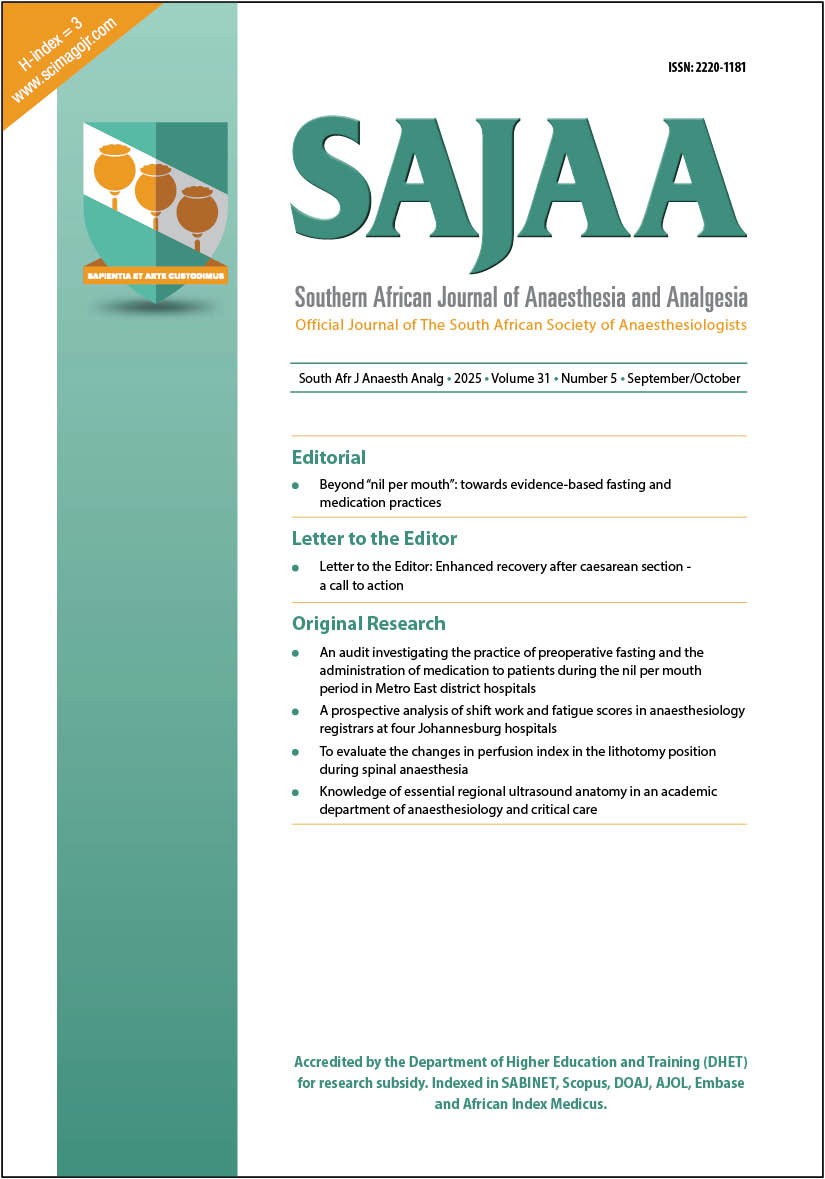Knowledge of essential regional ultrasound anatomy in an academic department of anaesthesiology and critical care
DOI:
https://doi.org/10.36303/SAJAA.3269Keywords:
knowledge, ultrasound-guided regional anaesthesia, training, competency, peripheral nerve blockAbstract
Background: Regional anaesthesia offers significant benefits for pain management, patient satisfaction, and surgical outcomes. Ultrasound-guided regional anaesthesia (UGRA) enhances accuracy and reduces complications; however, it requires thorough knowledge of sonoanatomy to avoid serious injuries. International guidelines now emphasise the concept of “Plan A blocks”, promoting standardised UGRA training with set core competencies. This study aimed to assess anaesthetists’ knowledge of the regional sonoanatomy of these Plan A blocks.
Methods: After ethical approval, a descriptive, cross-sectional study was conducted at an academic meeting in the Department of Anaesthesiology and Critical Care at Tygerberg Hospital. The questionnaire was face-validated by experienced providers according to published standards and contained general questions and ultrasound images of the seven Plan A blocks. Participants were asked to identify the block and label essential anatomical structures as defined in the literature.
Results: The academic meeting was attended by 54 anaesthetists and all were enrolled. All practised UGRA. According to the assessment, only 25.9% of participants had sufficient knowledge of regional ultrasound anatomy (could identify ≥ 60% of the structures). Most could identify the blocks but were unable to label the structures correctly. A statistically significant relationship could not be shown between anaesthesia experience and overall score on the Plan A blocks section of the questionnaire (F = 2.07, p = 0.07). A statistically significant relationship was found between experience and participants’ self-knowledge rating (F = 3.49, p = 0.006). Nearly all the participants (98.1%) believed that a formal teaching programme would be beneficial. Barriers to performing UGRA included lack of time, pressure from surgeons and unavailability of equipment.
Conclusion: Core knowledge of ultrasound anatomy is essential for anaesthetists performing UGRA to ensure patient safety and optimal outcomes. This study found that anaesthesia providers at Tygerberg Hospital lack sufficient knowledge of essential regional sonoanatomy specific to Plan A blocks, and suggest implementation of a formal training programme.
Downloads
Additional Files
Published
Issue
Section
License
Copyright (c) 2025 F Akoonjee, F Retief, M Jaworska, R Lockhat

This work is licensed under a Creative Commons Attribution-NonCommercial 4.0 International License.
By submitting manuscripts to SAJAA, authors of original articles are assigning copyright to the SA Society of Anaesthesiologists. Authors may use their own work after publication without written permission, provided they acknowledge the original source. Individuals and academic institutions may freely copy and distribute articles published in SAJAA for educational and research purposes without obtaining permission.
The work is licensed under a Creative Commons Attribution-Non-Commercial Works 4.0 South Africa License. The SAJAA does not hold itself responsible for statements made by the authors.

